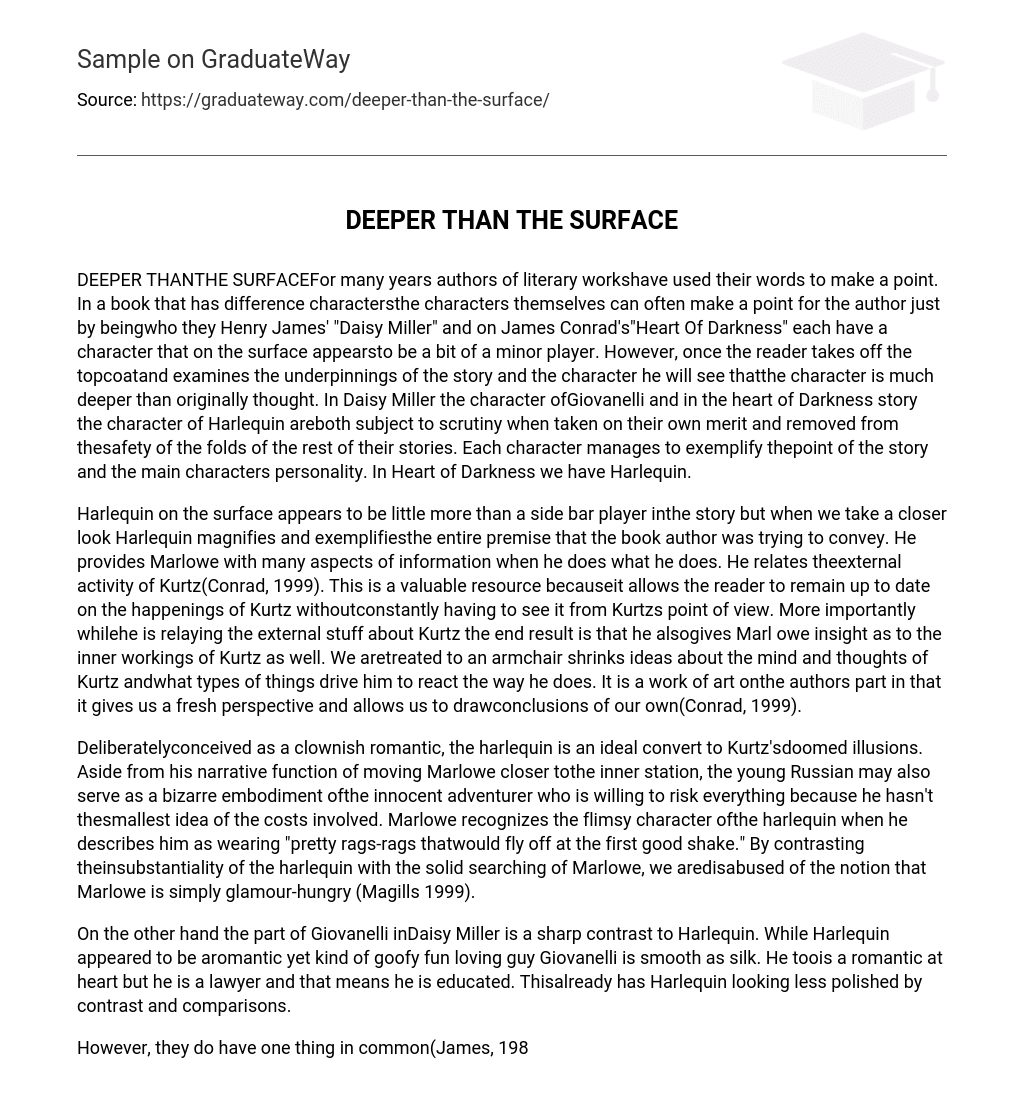For many years authors of literary workshave used their words to make a point. In a book that has difference charactersthe characters themselves can often make a point for the author just by beingwho they Henry James’ “Daisy Miller” and on James Conrad’s”Heart Of Darkness” each have a character that on the surface appearsto be a bit of a minor player.
However, once the reader takes off the topcoatand examines the underpinnings of the story and the character he will see thatthe character is much deeper than originally thought. In Daisy Miller the character ofGiovanelli and in the heart of Darkness story the character of Harlequin areboth subject to scrutiny when taken on their own merit and removed from thesafety of the folds of the rest of their stories. Each character manages to exemplify thepoint of the story and the main characters personality. In Heart of Darkness we have Harlequin.
Harlequin on the surface appears to be little more than a side bar player inthe story but when we take a closer look Harlequin magnifies and exemplifiesthe entire premise that the book author was trying to convey. He provides Marlowe with many aspects of information when he does what he does. He relates theexternal activity of Kurtz(Conrad, 1999).
This is a valuable resource becauseit allows the reader to remain up to date on the happenings of Kurtz withoutconstantly having to see it from Kurtzs point of view. More importantly whilehe is relaying the external stuff about Kurtz the end result is that he alsogives Marl owe insight as to the inner workings of Kurtz as well. We aretreated to an armchair shrinks ideas about the mind and thoughts of Kurtz andwhat types of things drive him to react the way he does. It is a work of art onthe authors part in that it gives us a fresh perspective and allows us to drawconclusions of our own(Conrad, 1999).
Deliberatelyconceived as a clownish romantic, the harlequin is an ideal convert to Kurtz’sdoomed illusions. Aside from his narrative function of moving Marlowe closer tothe inner station, the young Russian may also serve as a bizarre embodiment ofthe innocent adventurer who is willing to risk everything because he hasn’t thesmallest idea of the costs involved. Marlowe recognizes the flimsy character ofthe harlequin when he describes him as wearing “pretty rags-rags thatwould fly off at the first good shake.” By contrasting theinsubstantiality of the harlequin with the solid searching of Marlowe, we aredisabused of the notion that Marlowe is simply glamour-hungry (Magills 1999).
On the other hand the part of Giovanelli inDaisy Miller is a sharp contrast to Harlequin. While Harlequin appeared to be aromantic yet kind of goofy fun loving guy Giovanelli is smooth as silk. He toois a romantic at heart but he is a lawyer and that means he is educated. Thisalready has Harlequin looking less polished by contrast and comparisons.
However, they do have one thing in common(James, 1988). They both have tremendous insight as to the workings of human nature. Giovanelli understands that Daisy is only acting the way she has been broughtup to act in her homeland of America and it has no bearing on the type ofperson she is sexually. Harlequin understands Kurtz with equal clarity. He sees Daisy because she is the mostbeautiful girl he has ever been around though he knows no future can come ofthe relationship (James, 1988).
This is also thesituation with Kurtz however it is not on a love level that they mingle but theend result is the same. No hope of a future friendship but for entirelydifferent reasons (Conrad, 1999). Each story is a tale of love andadventure. Each story is a tale of people understanding the inner workings ofothers.
However the two stories are set in different nations, different erasand with different motivation. Harlequins and Giovanellis ability tounderstand the protagonist evidence the similarities. However their educationalbackgrounds, their ideas and beliefs and their purposes for being there aretotally different.
WORKS CITED
- James, Henry. Daisy Miller. (Penguin USA 1988)
- Conrad, Joseph. Heart of Darkness (Dover Thrift Editions1991)





